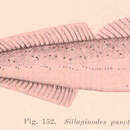Diagnostic Description
provided by Fishbase
The swim bladder is very elongate with a single slender tapering posterior extension and two anterolateral extensions. No duct-like urogenital aperture is present. Body color is pale brown, gray brown, or dark olive green above, and whitish pale brown or silvery below with reflections of mauve, blue green when fresh. The back and upper sides with oblique rows of small round dark brown to rusty brown spots; the lower sides with open-spaced rather scattered round dark spots. The belly is white and without spots. The dorsal fins are uniformly dark greenish brown to light brown sometimes spotted with dark brown; the anal, pectoral and pelvic fins are pale brown to hyaline; the caudal fin is greenish to brownish and finely dusted with brown (Ref. 6205).
Life Cycle
provided by Fishbase
Are serial batch spawners, yet the number of spawnings in a season is unknown (Ref. 6390).
Morphology
provided by Fishbase
Dorsal spines (total): 12 - 14; Dorsal soft rays (total): 25 - 27; Analspines: 2; Analsoft rays: 21 - 24
Trophic Strategy
provided by Fishbase
The larvae move inshore to sheltered areas and settle out of the plankton when 60-80 days old and 15-18 mm long (Ref. 27669). Juveniles remain in protected waters for 2-3 years. Older ones (more than 25 cm TL) move to deeper water, particularly during winter (Ref. 27008, 27667).
Biology
provided by Fishbase
Inhabit shallow inner continental shelf waters, including bays and inlets (Ref. 6390). For their first few years, they live mainly where seagrasses (Zostera species, Posidonia creeks. Small juveniles favor water depths from 2 m to 20 m. Adults inhabit more exposed waters along coastal beaches and reef areas (Ref. 27008, 27667), sometimes to depths as great as 200 m. Spawn in offshore waters from late summer to winter (Ref. 6390). Juveniles feed on benthic amphipods and other crustaceans. As they grow larger, their diet expands to include polychaete worms, mollusks and peanut worms (Sipuncula) (Ref. 27008, 27667). Oviparous (Ref. 205). This premium quality fish obtains a high price (Ref. 6205).
Importance
provided by Fishbase
fisheries: commercial; aquaculture: experimental; gamefish: yes

